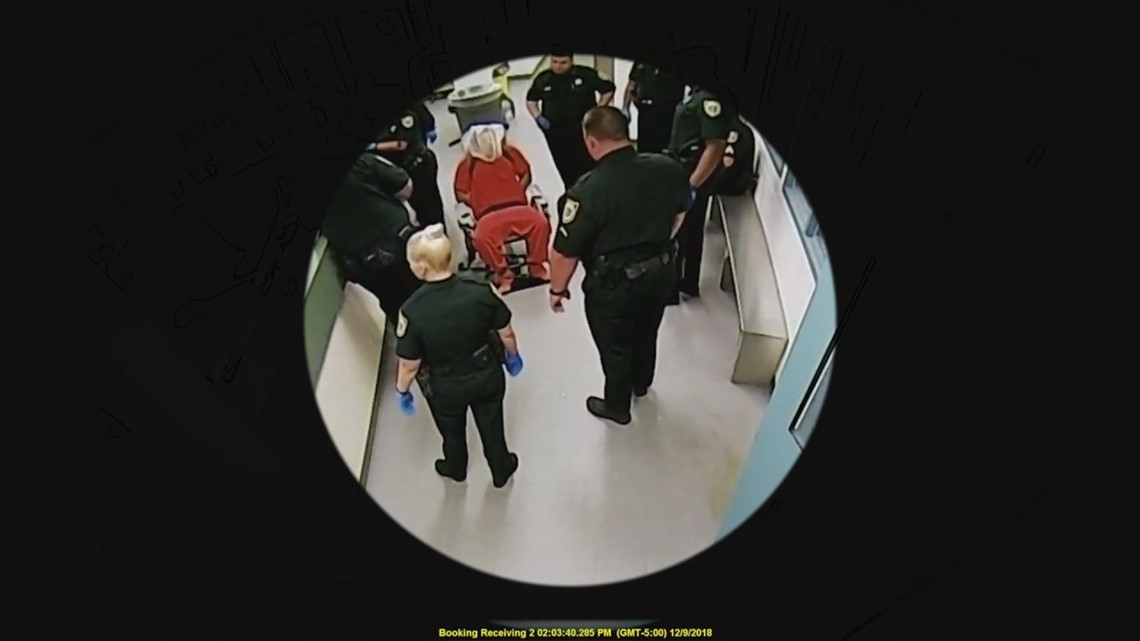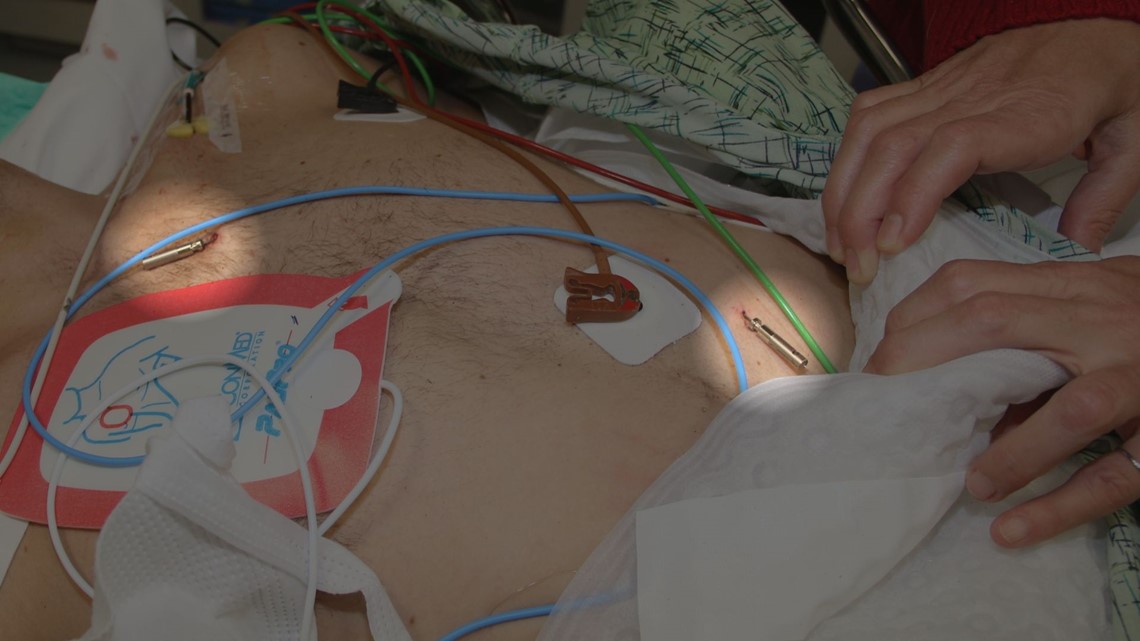TAMPA, Florida — Content warning: This story includes descriptions, images and videos of police using force on people who were struggling with their mental health and/or drug use.
“Call 911! They’re trying to murder me. Help me!” Anthony Pattinson said.
Body camera video shows him shirtless and walking around an intersection at night in April 2015, surrounded by Okaloosa County Sheriff’s Office deputies.
“We’re the police, man. You’re OK,” a deputy can be heard telling him.
Deputies handcuffed the veteran Air Force captain and bent him over the hood of a patrol car.
Minutes later, he had no pulse.
Pattinson is one of 78 Floridians whose deaths have been blamed on “excited delirium” since 2010.


10 Investigates found most of them died after law enforcement used force, restrained them, or both.
“Excited delirium” is basically a theory that sometimes people can get so amped up, and so agitated that they just die.
Critics call the term a cover-up because it mostly pops up when police restrain someone or use force.
This year, the National Association of Medical Examiners (NAME) turned its back on “excited delirium” as a cause of death.
So, what happens when you find out your loved one’s death may not match the government’s official explanation?
The things, people, and questions left behind
There are the things they left behind: Flip flops. Two champagne glasses surrounded by rose petals. Peppermints in a suit pocket.
Then there are the people they left behind, like Anthony Pattinson’s mother Mary Stephens, who rushed toward the flashing blue lights after her son was handcuffed.
“Calm down. It’s Mom. Calm down,” Stephens can be heard saying in a body camera recording. “He’s got Post-Traumatic Stress Syndrome.”
And the daughter Gregory Edwards never got to meet. His wife was pregnant when he died in December 2018.
Brevard County corrections deputies pepper-sprayed Edwards, shocked him with a Taser, handcuffed him, strapped him in a restraint chair, and put a “vented spit mask” on him. One deputy’s Taser recorded its trigger had been pulled six times, for a total of 49 seconds within two minutes.
Edwards’ wife said he was a veteran suffering from PTSD, as well.


And then there are the questions they left behind.
“There were never any answers. And nobody was ever made accountable for what happened. And I can’t get over that,” Hernando County mother Jude Saucier said.
In November 2012, Hernando County Sheriff’s Office records say a man reported Jude Saucier’s son Richard Saucier jumped on his car and tried to punch him, but missed.
“He stripped off all his clothes. And he was running down [Highway] 19,” Jude Saucier told 10 Investigates.


A sheriff's office report says a deputy fired their Taser five times for five seconds each.
“Give us your hands. Stop fighting or we’re going to Tase you again. Stop,” a deputy can be heard telling Richard Saucier in a dashcam recording.
Deputies reported Saucier was unresponsive by the time paramedics showed up.
“After he was Tased and handcuffed, his pulse was pounding at 150,” a deputy said.
The Taser prongs were found in his chest after he died.


“I did make a phone call to the police station to talk to the sheriff. Nobody ever called me back. And I had a lot of questions about why he was Tased so many times,” his mother said.
Richard Saucier’s autopsy report says combined drug toxicity played a role, but his cause of death was “excited delirium syndrome.”
Jude Saucier said she’d never heard of “excited delirium” until 10 Investigates called her, more than a decade after her son’s death.
“I think it’s a cover-up for the police department,” she said.


The Hernando County Sheriff’s Office wouldn’t meet us for an interview.
“We do not have anything new to add to the information that was already documented in 2012; therefore, we are respectfully declining the interview,” Hernando County Sheriff’s Office Media Relations Manager Denise Moloney said.
Moloney said the sheriff’s office typically uses force in fewer than five of 1,100 calls for involuntary mental health commitments each year.
“When the case agent called Jude Saucier to advise her the cause and manner of her son’s death, as listed on the autopsy report, was Excited Delirium Syndrome with Contributing Factors – she refused to speak with him, advising him to contact her lawyer; however, she failed to provide the name of the lawyer,” Moloney told 10 Investigates.
What is "excited delirium?"
Defining “excited delirium” is complicated since there’s disagreement about whether it’s even a real thing.
It’s been characterized over the years as a sudden state that can involve agitation, confusion, paranoia, hyperactivity, hallucinations, high body temperature, sweating, and incoherent shouting.
“Excited delirium” is sometimes reported in people who use stimulant drugs like cocaine or meth, and sometimes in people with mental health problems. Sometimes none of the above.
Critics say there’s not enough evidence it can kill people, and it’s been used to explain away deaths involving law enforcement.
“The phrase ‘excited delirium’ had become more of a catch-all for many, many circumstances that were difficult to explain. And we need a better understanding,” said Dr. Debra Pinals, recent past Chair of the American Psychiatric Association’s Council of Psychiatry and the Law.
Every major medical organization has now turned its back on “excited delirium.”
But police are still being trained that it’s real and they need to be ready for it.
“He was going crazy, like, excited delirium,” a Jacksonville Sheriff’s Officer can be heard saying in an August 2020 body camera recording.
Officers handcuffed Timothy Shawn Smith and put him in the “prone” position, lying on his stomach.
Sheriff’s office reports say Smith went into cardiac arrest and died at the hospital the next day.
The medical examiner ruled that Smith’s cause of death was “Complications of Excited Delirium Syndrome, with cardiac arrest and anoxic encephalopathy due to acute combined drug intoxication.”
Florida medical examiners avoid questions on “excited delirium”
This year, the National Association of Medical Examiners released a statement saying it no longer endorses “excited delirium” as a cause of death.
“Instead, NAME endorses that the underlying cause, natural or unnatural (to include trauma), for the delirious state be determined (if possible) and used for death certification,” the organization said in its statement.
So, what does that mean for people who already have it on their autopsy reports?
10 Investigates made our own database through hundreds of public records requests to medical examiners and law enforcement.
We found that Florida medical examiners have identified “excited delirium” as the official cause of death or contributing factor for 78 people since 2010.
At least 81% of those people died after law enforcement's use of force, restraint, or both.
And at least 32% were shocked with an electric weapon like a Taser before they died.
So, now that NAME has turned its back on “excited delirium,” are we going to stop seeing it on autopsy reports?
And are any medical examiners going to review their past cases?
10 Investigates reached out to every medical examiner in Florida. It was surprisingly tough to get answers.
A majority of Florida’s medical examiners would not give us a straight answer when we asked whether they would stop using “excited delirium” as a cause of death.
Only three out of Florida’s two dozen medical examiners told us they would review their past “excited delirium” cases.


Dr. Tom Coyne was one of the exceptions. He’s the medical examiner for Florida’s District 8, which covers Dixie, Alachua, Baker, Bradford, Gilchrist, Levy, and Union counties.
He said “excited delirium” is real, but he won’t use it as a cause of death in the future because it’s become too controversial.
“By not using the term ‘excited delirium,’ you’re forcing the physician to think about, what is the process that created that scenario?” Coyne said. “Was it drug toxicity? Was it an underlying medical disease?”
We asked Coyne how “excited delirium” can kill someone.
“Your heart can only beat that hard that long until it fails,” he said. “A person dies in that setting because they've reached their max point of exhaustion. And, unfortunately, it happens to be when they are either restrained, or handcuffed, or on a stretcher, or being transported to the hospital.”


Forensic epidemiologist Dr. Michael Freeman co-authored a 2020 study that found, “There is no existing evidence that indicates that EXDS [Excited Delirium Syndrome] is inherently lethal in the absence of aggressive restraint.”
“When there’s law enforcement involved and the death occurs during restraint, that’s when the term ‘excited delirium’ is invoked,” Freeman said.
We asked Coyne if restraining, Tasering, or giving sedatives to a person who’s experiencing extreme exhaustion and elevated heart rate could make them more likely to die.
“No. It’s difficult, right? Because the problem here is that you have to administer treatments to these patients,” Coyne said. “But they're not in a state that is receptive for treatment. In other words, they are fighting back against you.... There has been plenty of examples of restraint-associated deaths, but for the most part, in these cases, what is really dangerous is the underlying entity itself, not the restraint that is involved.”


So, what happens to the people left behind?
Jude Saucier says she’s done staying silent.
“I want something done so this doesn’t happen to somebody else,” she said. “I have to protect him through death and life. And I always will. He’s my son. You know, you don’t give up on your children, ever.”
Last month, California became the first state to pass a law banning medical examiners from listing “excited delirium” as a cause of death.
Florida’s legislative session begins Jan. 9.

